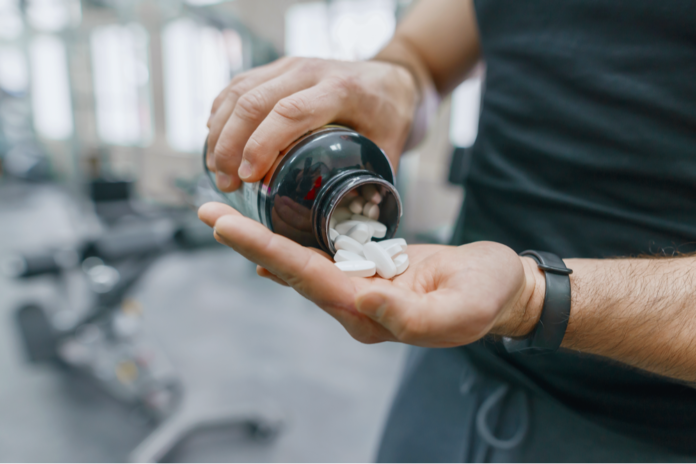Many micronutrients play vital roles in energy metabolism, which is heightened 20 to 100 times during exercise compared to the resting rate!
A deficiency in micronutrients, even marginally, can negatively impact exercise performance. Furthermore, exercise can increase the need for supplemental micronutrients to meet the demands of energy output.
Read on to learn more about the importance of micronutrients and how they vitally impact physical activity!
What Are Micronutrients?
Whereas macronutrients include carbohydrates, protein, and fat, micronutrients include all major vitamins and minerals.
Macronutrients play roles in the major functions of energy production, muscle growth and repair, and other metabolic functions. Micronutrients are the mighty helpers of these reactions. The body requires smaller amounts of micronutrients compared to macronutrients, but they are equally as vital.
In general, vitamins are cofactors for energy production, immune function, and blood clotting and are organic compounds formed by plants and animals that can be broken down by heat, acid, or air. On the other hand, minerals play key roles in growth, bone health, and fluid and pH balance amongst several other functions. They are also inorganic molecules that exist in soil and water and cannot be broken down.
One obtains micronutrients through plant and animal foods. Different foods contain unique and differing amounts of vitamins and minerals. They often correlate with different colors, so this is why it’s important to eat a variety of foods.
Plus, each micronutrient contributes different functions for the body, so adequate intake of all of them is vital.
Types and Functions of Micronutrients
Vitamins and minerals can further be divided into four categories:
- Fat-soluble vitamins
- Water-soluble vitamins
- Macrominerals
- Trace minerals
All of these vitamins and minerals are absorbed similarly and interact together to exert their functions.
Fat-Soluble Vitamins
Fat-soluble vitamins do not dissolve in water, are stored in the liver and fatty acids, and are best absorbed when consumed alongside a fat source.
The main roles and sources of the various fat-soluble vitamins include:
- Vitamin A: proper vision and organ function; sweet potatoes, carrots, spinach, liver, dairy, fish
- Vitamin D: optimal immune function, calcium absorption, and bone growth; sunlight, fish oil, milk
- Vitamin E: optimal immune function and acts as an antioxidant that protects cells from damage; sunflower seeds, wheat germ, almonds
- Vitamin K: blood clotting and proper bone development; leafy greens, soy, pumpkin
Water-Soluble Vitamins
The majority of vitamins are water-soluble, simply meaning they dissolve in water and are flushed out via urine if consumed in excess rather than stored in the body for later use like fat-soluble vitamins.
Compared to the prior vitamins, water-soluble vitamin functions are intricately related, with most acting as coenzymes or cofactors that catalyze important metabolic reactions for energy production.
These vitamins, their main roles, and sources of each include:
- Vitamin B1 (thiamine): helps convert essential nutrients into energy; whole grains, meat, fish
- Vitamin B2 (riboflavin): energy production, cell function and fat metabolism; organ meats, eggs, milk
- Vitamin B3 (niacin): drives energy production from food; meat, salmon, leafy greens, beans
- Vitamin B5 (pantothenic acid): fatty acid synthesis; organ meats, mushrooms, tuna, avocado
- Vitamin B6 (pyridoxine): helps release sugar from starches for energy and creates red blood cells; fish, milk, carrots, potatoes
- Vitamin B7 (biotin): fatty acid, amino acid and glucose metabolism; almonds, eggs, spinach, sweet potatoes
- Vitamin B9 (folate): proper cell division; asparagus, beef, black-eyed peas, spinach
- Vitamin B12 (cobalamin): red blood cell formation and nervous system and brain function; clams, fish, meat
- Vitamin C (ascorbic acid): create neurotransmitters, collagen production, and serves as a main protein in skin elasticity; bell peppers, brussel sprouts, citrus fruits
Macrominerals
The body needs larger amounts of macrominerals compared to trace minerals to assert their functional roles.
These minerals, their main roles, and sources of each include:
- Calcium: structure and function of bones and teeth and assists in muscle and blood vessel contraction; broccoli, leafy greens, milk products
- Phosphorus: bone and cell membrane structure; salmon, turkey, yogurt
- Magnesium: assists in over 300 enzymatic reactions; almonds, black beans, cashews
- Sodium: electrolyte that aids fluid balance and maintenance of blood pressure; processed foods, salt
- Chloride: maintains fluid balance and used to make digestive juices; celery, salt, seaweed
- Potassium: electrolyte that maintains fluid status in cells and helps with nerve transmission and muscle contraction; acorn squash, bananas, lentils
- Sulfur: part of every living tissue; brussel sprouts, eggs, garlic, mineral water, onions
Trace Minerals
These minerals are required in smaller amounts but still exert equally important functions in the body.
These minerals, their main roles, and sources of each include:
- Iron: delivers oxygen to muscles and assists in creation of some hormones; oysters, spinach, white beans
- Manganese: carbohydrate, amino acid and cholesterol metabolism; peanuts, pecans, pineapple
- Copper: connective tissue formation and brain and nervous system function; cashews, crabs, liver
- Zinc: growth, immune function and wound healing; chickpeas, crab, oysters
- Iodine: thyroid regulation; cod, seaweed, yogurt
- Fluoride: development of bones and teeth; crab, fruit juice, water
- Selenium: thyroid health, reproduction and defense against oxidative damage; brazil nuts, ham, sardines
How Do Micronutrients Affect Fitness?
Everyone needs different amounts of micronutrients due to bio-individuality. Several factors affect personal micronutrient needs like genetics, age, lifestyle, injuries, sickness, absorption rate, and intensity of physical training.
An athlete’s need for micronutrients fluctuates, depending on the intensity and duration of training. For example, mineral depletion is common after high-intensity exercise and higher levels of folate and vitamin B12 are needed to repair damaged cells and create new ones, especially red blood cells.
Furthermore, because micronutrients work synergistically, as the need for one increases, oftentimes, the need for an additional does too. For example, vitamin C increases the absorption of iron and vitamin D is necessary for the full metabolism of calcium. On the other hand, more is not always better because too much of one micronutrient can deplete a different one or evoke toxicity.
Generally speaking, the most important micronutrients of consideration in direct relation to fitness include vitamin B3 (niacin), B6 (pyridoxine), B7 (biotin), B12 (cobalamin), C, D, and E; and the minerals calcium, magnesium, sodium, potassium, iron, and manganese.
The main functions of micronutrients in relation to exercise include muscle recovery, energy production, and more.
Muscle Recovery and Fatigue
The body’s nutritional reserve of micronutrients largely affects the body’s ability to recover optimally and delay fatigue in subsequent workouts. Vitamin C can reduce muscle soreness and decrease levels of enzymes associated with muscle damage.
In addition, folic acid can help improve smooth muscle function and blood flow during and after training.
Cellular Energy Production
Mitochondria are considered the power horses of muscles, nerves, and heart. The most important ones involved in mitochondrial function and therefore energy production include biotin, vitamin B1, B2, B3, B6, A, and E.
Minimizing Oxidative Stress
Strenuous physical training generates oxidative stress on cells, so maximizing antioxidant status in athletes is critical for post-workout healing.
Vitamin C and E help prevent cellular damage, decrease isoprostanes, compounds formed during times of high oxidative stress, and help maintain higher levels of chromium, manganese, copper, zinc, and calcium.
Immunity and Hormone Regulation
Although not necessarily directly related to exercise, maintaining high immune function is vital for optimal exercise performance. While moderate or sufficient exercise improves immune function, over-training actually diminishes the immune system.
Nearly all micronutrients play parts in preserving immunity, so eating a big variety of foods of different colors is vital.
The Bottom Line
Micronutrients are vitamins and minerals derived from food. They play roles in nearly all metabolic and many chemical reactions within the body, and deficiencies of any of them can systematically affect the body in negative ways. One of their main functions includes fueling energy production for exercise.
While each micronutrient exerts unique functions, they work synergistically with each other, especially during physical activity. In terms of exercise, they correlate with muscle recovery and preservation, cellular energy production or muscle contraction, minimizing oxidative stress, and immunity.
While vital to maintain adequate amounts of each micronutrient through a healthy diet and/or supplementation, the most important ones in terms of exercise include vitamin B3 (niacin), B6 (pyridoxine), B7 (biotin), B12 (cobalamin), C, D, and E; and the minerals calcium, magnesium, sodium, potassium, iron, and manganese.
References:
P2P Education Expert. The Role of Micronutrients in Sports Medicine. Power2Practice. Republished September 17, 2018. www.power2practice.com/article/micronutrients-sports-medicine/.
Streit L. Micronutrients: Types, Functions, Benefits and More. Healthline. Published September 27, 2018. www.healthline.com/nutrition/micronutrients.









